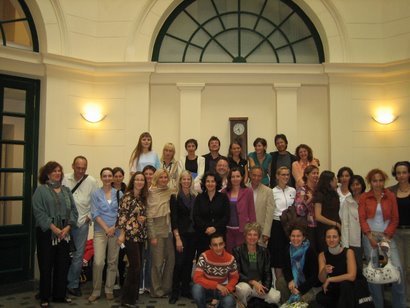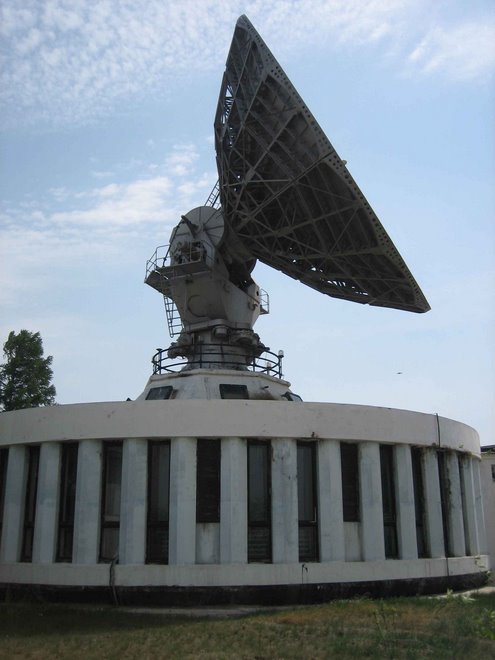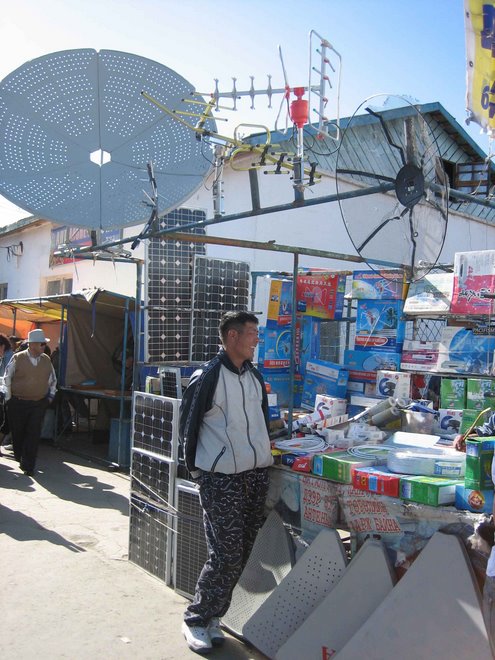Check out my essay "Obscure Objects of Media Studies: Echo, Hotbird and Ikonos" which was just published in the online journal Mediascape.
You can find it here:
www.tft.ucla.edu/mediascape/archive/volume01/number03/columns/parks.htm
Thursday, May 31, 2007
Wednesday, May 30, 2007
Down to Earth - CFP
I am co-editing a new book with Jim Schwoch. Here is the call for papers for those who might be interested in contributing.
Call for Papers for Edited Collection on Satellites
Down to Earth:
Satellite Technologies, Industries and Cultures
Editors, Lisa Parks and James Schwoch
The satellite era marks its 50th anniversary in October 2007. Within 5 years of the Sputnik launch, Telstar in 1962 opened the door to networking television via satellite. By the end of the 1960s, both INTELSAT and INTERSPUTNIK operated as satellite constellations capable of relaying global television and other electronic information. ANIK in 1973 and HBO in 1975 moved to satellite as a distribution technology for reaching local television and cable operators, and by the early 1980s virtually every other cable service and terrestrial TV network had followed ANIK and HBO into the heavens. The end of this current decade will also mark the first full generation of global satellite TV distribution: 30 years as an industry norm. Television stands as just one of many significant examples representing the integration of satellite technology and global information flows over the past half-century. Satellite industries now also include remote sensing and global positioning systems and satellite radio and broadband services as well.
Despite the centrality of satellite technologies and services in so many aspects of contemporary life, various histories and practices key to these systems and services remain, by comparison to other means of global electronic information and entertainment, relatively unknown to most observers. In the field of global media, for example, scholars and students are much more likely to be able to name the major Hollywood film studios (whether in contemporary or historical context), the various television and cable networks of the world, the major news services, at least a handful of the leading global newspapers, or the major computer and entertainment technology manufacturers than they are able to name individual satellites, satellite constellations, or various services. Details about the satellite industry, from financing to launch to service applications, remain hazy at best. The perception of various orbits-even the awareness that there are many possible orbital configurations-is often dim. And how and why satellites help configure contemporary politics and culture at both global and local levels is only glimpsed rather than seen in detail. These knowledge gaps regarding satellite technologies, industries and cultures are found in a wide range of fields and disciplines addressing global issues.
This collection aims to expand awareness and knowledge about satellites beyond a base of talented specialists and experts, thereby reaching out to many more who are interested in global media and other global issues, yet may find themselves at somewhat of an impasse when it comes to thinking about satellites with the same familiarity as they may think about global TV news networks, computer software moguls, or film studios (be they Hollywood, Bollywood, Hong Kong, or others.) As such, this edited volume aims to more fully chart satellites into the maps and atlases of global media knowledge, and do so in both historical and contemporary settings.
Toward that end, we issue this call for book chapters and materials suitable for an edited collection, and seek contributors who share the goal of expanding knowledge of satellite technologies, industries and cultures. We are especially interested in work that is set beyond the US and Western Europe, in original research and accessible writing, and work that exemplifies new ways of researching and thinking about satellites and their implications. We also welcome work that integrates visual materials whether photographs, drawings, maps, diagrams, notes, or charts. The project will bring together historical and theoretical perspectives, and will accommodate interdisciplinary approaches as well. We invite submissions from international scholars and writers working within or across any of the following fields: communication and media studies, history of science and technology, cultural studies, geography, security studies, international relations, economics, sociology, anthropology, information sciences, legal studies and global studies.
Organization
We envision an organizational schema that foregrounds satellites and their systems. By that, we mean various sections that are named and organized by the following possible examples:
o Satellites and constellations
o Launch facilities and orbits
o Footprints and services
o Manufacturers, ground stations, and operators
o Users, programmers, and consumers of content
Within each section, individual chapters and other appropriate materials will be placed that serve a dual purpose: showing the importance of understanding a particular facet of satellites and their systems, and also showing how those satellites and systems interact with, and open possibilities for, discussion and analysis of such issues as politics, culture, technology, nationalism, entertainment, security, conflict, globalization, local knowledge, and other concerns.
For example, a section on “satellites and constellations” could thematically organize essays centering on such topics as Sputnik(s); Telstar; Corona; INTELSAT; or Iridium. “Launch facilities and orbits” might contain articles on the California satellite coast; the geosynchronous orbit; Baikonur; French Guiana; polar orbits from oceanography to espionage; Sea Launch and Pegasus; or the emergent facilities in places such as Brazil, Japan, or India. “Footprints and services” might hold such topics as satellite broadcasting and diasporic communities; Google and remote sensing; or GPS navigation interfaces. All areas are prime locales for political, cultural, and ideological explorations.
Thinking further along the lines of potential contributions, we provide a representative sample of potential topics. This list is not exhaustive, but rather illustrative:
o Discussion of satellite manufacturers (ie Hughes, Alcatel, China) and/or ethnographies of workers in satellite industries from clean room to ground station, from signal transmission to dish installation.
o Detailed studies of launching sites whether in Kagoshima, Japan, Vandenberg Air Force Base, California, Tyuratam, Kazakhstan, Kourou, French Guiana or Xichang, China.
o History and analysis of specific satellites and constellations that move beyond technical description to engage with their implications upon institutions, industries, citizen-consumers and international relations.
o Development and uses of satellites by countries in Eastern Europe, East Asia, Africa, Middle East, South America and by indigenous communities.
o History and analysis of satellite-based media such as satellite images in TV news broadcasts, Googleearth interfaces, global news networks such as CNN, BBC World, Al Jazeera, satellite film exhibition (ie Bounce) or satellite radio programming.
o Discussion of regulatory histories and international treaties related to satellites including legal concepts that define and organize orbital and air space, satellite traffic and capacity, sovereignty, spillover.
o Analysis of emerging satellite industries such as broadband delivery, satellite radio (Sirius and Worldspace), GPS navigation systems, bitsys (personal satellites)
o Investigations of satellite technologies and cultures that interrogate issues such as international security; climatology; geographic information systems; archaeology; entrepreneurship; secrecy; and/or privatization.
o Satellites as a central theme in science and technology research, including government funding; as a central theme in successful and failed business ventures; as a transformative technology for rethinking and reformulating theories and practices of scientific enterprise and research.
Beyond the contributions gathered and contained in the various sections, the editors will also provide a general introduction as well as section introductions; a glossary of satellite terminology; and arrange for an index as part of the publication process.
PROPOSALS: We ask that potential contributors send a 250-500 word abstract (and full essay if already written), select bibliography, and brief biographical statement with the subject heading “Down to Earth” to both editors via e-mail at:
James Schwoch (j-schwoch@northwestern.edu)
Lisa Parks (parks@filmandmedia.ucsb.edu)
DEADLINE: July 15, 2007.
If you have questions about the project, feel free to contact either one of us. Completed essays will be due in Fall 2008.
About the Editors
LISA PARKS is Associate Professor of Film and Media Studies at the University of California-Santa Barbara. She is the author of Cultures in Orbit: Satellites and the Televisual (Duke 2005) and co-editor of Planet TV: A Global Television Reader (NYU 2003). In 2006/2007 she is a research fellow at the Wissenschaftskolleg (Institute for Advanced Study) in Berlin where she is writing a new book entitled Mixed Signals: Media Infrastructures and Cultural Geographies that explores satellite and wireless systems on the outskirts of Europe. Parks sits on the editorial boards of journals such as Cultural Studies, Film Quarterly, Mediascape, and The Velvet Light Trap. She directs the Global Cultures in Transition research initiative for the Center for Information Technology and Society at UCSB and serves on the system-wide advisory committee of the UC Humanities Research Institute. She has conducted research and given lectures in international contexts and teaches courses such as global media, war and media, television history, technology zones, and media art and activism, which deal with aspects of satellite technologies and cultures.
JAMES SCHWOCH is on the faculty of Northwestern University, where his research and teaching explores a nexus of global media, media history, diplomacy and security, international studies, science and technology studies, and research methodologies. Schwoch also convenes the Technology, Politics, and Culture seminar series of the Newberry Library in Chicago. His forthcoming book Global TV: New Media and the Cold War, 1946-1969 will be published in 2007 or 2008 by University of Illinois Press. Previous books include Questions of Method in Cultural Studies (Blackwell, 2005, 2006); Media History: Nordic Views (Jyvaskyla, 1996); Media Knowledge (SUNY, 1992); and The American Radio Industry and Its Latin American Activities, 1900-1939 (Illinois, 1990). Schwoch has held fellowships and grants from the Fulbright Commission (Finland 2005, Germany 1997); the National Science Foundation (1998-2002); the Ford Foundation (1997-2001); the National Endowment for the Humanities (1986, 1989), and the Center for Strategic and International Studies, where he was the Leonard Marks Fellow in International Communication Policy in 1997-98. He has also held visiting faculty appointments in Finland in 1994 (Tampere), 1996 (Jyvaskyla), and 2005 (Helsinki). For the past 15 years, Schwoch has consistently taught satellite-related material and research topics in both his undergraduate classes and graduate seminars.
Call for Papers for Edited Collection on Satellites
Down to Earth:
Satellite Technologies, Industries and Cultures
Editors, Lisa Parks and James Schwoch
The satellite era marks its 50th anniversary in October 2007. Within 5 years of the Sputnik launch, Telstar in 1962 opened the door to networking television via satellite. By the end of the 1960s, both INTELSAT and INTERSPUTNIK operated as satellite constellations capable of relaying global television and other electronic information. ANIK in 1973 and HBO in 1975 moved to satellite as a distribution technology for reaching local television and cable operators, and by the early 1980s virtually every other cable service and terrestrial TV network had followed ANIK and HBO into the heavens. The end of this current decade will also mark the first full generation of global satellite TV distribution: 30 years as an industry norm. Television stands as just one of many significant examples representing the integration of satellite technology and global information flows over the past half-century. Satellite industries now also include remote sensing and global positioning systems and satellite radio and broadband services as well.
Despite the centrality of satellite technologies and services in so many aspects of contemporary life, various histories and practices key to these systems and services remain, by comparison to other means of global electronic information and entertainment, relatively unknown to most observers. In the field of global media, for example, scholars and students are much more likely to be able to name the major Hollywood film studios (whether in contemporary or historical context), the various television and cable networks of the world, the major news services, at least a handful of the leading global newspapers, or the major computer and entertainment technology manufacturers than they are able to name individual satellites, satellite constellations, or various services. Details about the satellite industry, from financing to launch to service applications, remain hazy at best. The perception of various orbits-even the awareness that there are many possible orbital configurations-is often dim. And how and why satellites help configure contemporary politics and culture at both global and local levels is only glimpsed rather than seen in detail. These knowledge gaps regarding satellite technologies, industries and cultures are found in a wide range of fields and disciplines addressing global issues.
This collection aims to expand awareness and knowledge about satellites beyond a base of talented specialists and experts, thereby reaching out to many more who are interested in global media and other global issues, yet may find themselves at somewhat of an impasse when it comes to thinking about satellites with the same familiarity as they may think about global TV news networks, computer software moguls, or film studios (be they Hollywood, Bollywood, Hong Kong, or others.) As such, this edited volume aims to more fully chart satellites into the maps and atlases of global media knowledge, and do so in both historical and contemporary settings.
Toward that end, we issue this call for book chapters and materials suitable for an edited collection, and seek contributors who share the goal of expanding knowledge of satellite technologies, industries and cultures. We are especially interested in work that is set beyond the US and Western Europe, in original research and accessible writing, and work that exemplifies new ways of researching and thinking about satellites and their implications. We also welcome work that integrates visual materials whether photographs, drawings, maps, diagrams, notes, or charts. The project will bring together historical and theoretical perspectives, and will accommodate interdisciplinary approaches as well. We invite submissions from international scholars and writers working within or across any of the following fields: communication and media studies, history of science and technology, cultural studies, geography, security studies, international relations, economics, sociology, anthropology, information sciences, legal studies and global studies.
Organization
We envision an organizational schema that foregrounds satellites and their systems. By that, we mean various sections that are named and organized by the following possible examples:
o Satellites and constellations
o Launch facilities and orbits
o Footprints and services
o Manufacturers, ground stations, and operators
o Users, programmers, and consumers of content
Within each section, individual chapters and other appropriate materials will be placed that serve a dual purpose: showing the importance of understanding a particular facet of satellites and their systems, and also showing how those satellites and systems interact with, and open possibilities for, discussion and analysis of such issues as politics, culture, technology, nationalism, entertainment, security, conflict, globalization, local knowledge, and other concerns.
For example, a section on “satellites and constellations” could thematically organize essays centering on such topics as Sputnik(s); Telstar; Corona; INTELSAT; or Iridium. “Launch facilities and orbits” might contain articles on the California satellite coast; the geosynchronous orbit; Baikonur; French Guiana; polar orbits from oceanography to espionage; Sea Launch and Pegasus; or the emergent facilities in places such as Brazil, Japan, or India. “Footprints and services” might hold such topics as satellite broadcasting and diasporic communities; Google and remote sensing; or GPS navigation interfaces. All areas are prime locales for political, cultural, and ideological explorations.
Thinking further along the lines of potential contributions, we provide a representative sample of potential topics. This list is not exhaustive, but rather illustrative:
o Discussion of satellite manufacturers (ie Hughes, Alcatel, China) and/or ethnographies of workers in satellite industries from clean room to ground station, from signal transmission to dish installation.
o Detailed studies of launching sites whether in Kagoshima, Japan, Vandenberg Air Force Base, California, Tyuratam, Kazakhstan, Kourou, French Guiana or Xichang, China.
o History and analysis of specific satellites and constellations that move beyond technical description to engage with their implications upon institutions, industries, citizen-consumers and international relations.
o Development and uses of satellites by countries in Eastern Europe, East Asia, Africa, Middle East, South America and by indigenous communities.
o History and analysis of satellite-based media such as satellite images in TV news broadcasts, Googleearth interfaces, global news networks such as CNN, BBC World, Al Jazeera, satellite film exhibition (ie Bounce) or satellite radio programming.
o Discussion of regulatory histories and international treaties related to satellites including legal concepts that define and organize orbital and air space, satellite traffic and capacity, sovereignty, spillover.
o Analysis of emerging satellite industries such as broadband delivery, satellite radio (Sirius and Worldspace), GPS navigation systems, bitsys (personal satellites)
o Investigations of satellite technologies and cultures that interrogate issues such as international security; climatology; geographic information systems; archaeology; entrepreneurship; secrecy; and/or privatization.
o Satellites as a central theme in science and technology research, including government funding; as a central theme in successful and failed business ventures; as a transformative technology for rethinking and reformulating theories and practices of scientific enterprise and research.
Beyond the contributions gathered and contained in the various sections, the editors will also provide a general introduction as well as section introductions; a glossary of satellite terminology; and arrange for an index as part of the publication process.
PROPOSALS: We ask that potential contributors send a 250-500 word abstract (and full essay if already written), select bibliography, and brief biographical statement with the subject heading “Down to Earth” to both editors via e-mail at:
James Schwoch (j-schwoch@northwestern.edu)
Lisa Parks (parks@filmandmedia.ucsb.edu)
DEADLINE: July 15, 2007.
If you have questions about the project, feel free to contact either one of us. Completed essays will be due in Fall 2008.
About the Editors
LISA PARKS is Associate Professor of Film and Media Studies at the University of California-Santa Barbara. She is the author of Cultures in Orbit: Satellites and the Televisual (Duke 2005) and co-editor of Planet TV: A Global Television Reader (NYU 2003). In 2006/2007 she is a research fellow at the Wissenschaftskolleg (Institute for Advanced Study) in Berlin where she is writing a new book entitled Mixed Signals: Media Infrastructures and Cultural Geographies that explores satellite and wireless systems on the outskirts of Europe. Parks sits on the editorial boards of journals such as Cultural Studies, Film Quarterly, Mediascape, and The Velvet Light Trap. She directs the Global Cultures in Transition research initiative for the Center for Information Technology and Society at UCSB and serves on the system-wide advisory committee of the UC Humanities Research Institute. She has conducted research and given lectures in international contexts and teaches courses such as global media, war and media, television history, technology zones, and media art and activism, which deal with aspects of satellite technologies and cultures.
JAMES SCHWOCH is on the faculty of Northwestern University, where his research and teaching explores a nexus of global media, media history, diplomacy and security, international studies, science and technology studies, and research methodologies. Schwoch also convenes the Technology, Politics, and Culture seminar series of the Newberry Library in Chicago. His forthcoming book Global TV: New Media and the Cold War, 1946-1969 will be published in 2007 or 2008 by University of Illinois Press. Previous books include Questions of Method in Cultural Studies (Blackwell, 2005, 2006); Media History: Nordic Views (Jyvaskyla, 1996); Media Knowledge (SUNY, 1992); and The American Radio Industry and Its Latin American Activities, 1900-1939 (Illinois, 1990). Schwoch has held fellowships and grants from the Fulbright Commission (Finland 2005, Germany 1997); the National Science Foundation (1998-2002); the Ford Foundation (1997-2001); the National Endowment for the Humanities (1986, 1989), and the Center for Strategic and International Studies, where he was the Leonard Marks Fellow in International Communication Policy in 1997-98. He has also held visiting faculty appointments in Finland in 1994 (Tampere), 1996 (Jyvaskyla), and 2005 (Helsinki). For the past 15 years, Schwoch has consistently taught satellite-related material and research topics in both his undergraduate classes and graduate seminars.
Tuesday, May 29, 2007
Welcome
Welcome to Mixed Signals! This is a blog that I am setting up in the midst of writing a new book on media technologies, cultural geography, and globalization. I would like to try and use this space to gather thoughts, think out loud, post images, and interact with others who share interests. I have been in Berlin for the last 7 months working as a research fellow at the Institute for Advanced Study (Wissenschaftskolleg, www.wiko-berlin.de), and am preparing for a research trip to Mongolia later this week.
Here is a brief summary of my project:
Modern media research could be categorized into four areas: 1) aesthetic/formal analysis; 2) industrial/regulatory analysis; 3) discourse/representational analysis; and 4) reception/audience analysis. In general, the research has concentrated upon relations of production and consumption, exploring particular conditions that have generated various forms of audiovisual culture and the contexts in which they have been consumed, whether the cinema, living room, art gallery, or mobile interface, among others. Fewer researchers have tackled the issue of distribution, considering how the dissemination of media transpires through a series of networks dispersed across time/space and enmeshed with histories of international trade, geopolitics, and technological development. Those scholars who have focused upon such issues (Innis, Mattelart, Schiller, Castells) have narrated a tale of Western imperialism, emphasizing how industrial nation-states fueled the formation of culture industries during the 19th and 20th centuries that were exported throughout the world with a potentially homogenizing effect, threatening a vibrant array of languages and cultures. This position, now understood as the “media imperialism thesis,” drew crucial attention to the hegemonic power plays inherent in the globalization of media, but tended to overlook local/national negotiation or contestation of such processes along with variations across territorial and socio-economic contexts. Furthermore, the thesis implicitly established the industrial West as the standard against which all the world’s media cultures are measured and evaluated.
Mixed Signals explores media infrastructures in three sites on the outskirts of Europe – former Yugoslavia, Mongolia and Turkey. By examining former Yugoslavia, a socialist country that underwent a major civil war and political restructuring during the 1990s, Mongolia, a former protectorate of the Soviet Union that asserted its independence in the 1990s and has been supported by institutions in Western Europe and the US, and Turkey, a secular Islamic state on the cusp of joining the EU, I delineate how media infrastructures and cultures that surround them are implicated in geopolitical, economic and cultural campaigns on the thresholds of South-eastern Europe, Eurasia and the Middle East. Media infrastructures connect regions to other larger entities, whether multinational media corporations, international political organizations, or diasporic communities, and their development intersects with historical trade routes, migration/displacement, and patterns of communication.
Drawing upon recent work in cultural geography (Thrift), anthropology (Appadurai, Clifford), and media studies (Morley) I try to supplement and complicate the media imperialism thesis in three ways. First, to deal with the issue of distribution I visit and document specific infrastructures sites. Rather than approach them as inert technical systems that can be contained and comprehended in a flow diagram, I insist upon their embeddedness within social and historical conditions (Marvin & Graham), and set out to visualize infrastructure sites and their surroundings, stressing the differences that emerge when we study them in a transnational context. Second, rather than study the global flows of media from sites with high production and/or consumption rates (i.e. Hollywood or Bollywood), I examine media in peripheral societies that have undergone substantial political and economic transitions during recent years, and, because of their location, are implicated within geopolitical and geoeconomic strategies designed to bolster relations between the West and the East and South. Finally, instead of than treat media as screen-based phenomena alone, I consider them as signals (and potentials) that circulate in an imperceptible territory known as the electromagnetic spectrum, which has an organization that is both charged with and symptomatic of power dynamics on earth. Throughout the book, I develop the concept of cultural atmospherics to describe media infrastructures and their surroundings, trying to move toward a more spatial, even environmental, approach to the study of media.
Here is a brief summary of my project:
Modern media research could be categorized into four areas: 1) aesthetic/formal analysis; 2) industrial/regulatory analysis; 3) discourse/representational analysis; and 4) reception/audience analysis. In general, the research has concentrated upon relations of production and consumption, exploring particular conditions that have generated various forms of audiovisual culture and the contexts in which they have been consumed, whether the cinema, living room, art gallery, or mobile interface, among others. Fewer researchers have tackled the issue of distribution, considering how the dissemination of media transpires through a series of networks dispersed across time/space and enmeshed with histories of international trade, geopolitics, and technological development. Those scholars who have focused upon such issues (Innis, Mattelart, Schiller, Castells) have narrated a tale of Western imperialism, emphasizing how industrial nation-states fueled the formation of culture industries during the 19th and 20th centuries that were exported throughout the world with a potentially homogenizing effect, threatening a vibrant array of languages and cultures. This position, now understood as the “media imperialism thesis,” drew crucial attention to the hegemonic power plays inherent in the globalization of media, but tended to overlook local/national negotiation or contestation of such processes along with variations across territorial and socio-economic contexts. Furthermore, the thesis implicitly established the industrial West as the standard against which all the world’s media cultures are measured and evaluated.
Mixed Signals explores media infrastructures in three sites on the outskirts of Europe – former Yugoslavia, Mongolia and Turkey. By examining former Yugoslavia, a socialist country that underwent a major civil war and political restructuring during the 1990s, Mongolia, a former protectorate of the Soviet Union that asserted its independence in the 1990s and has been supported by institutions in Western Europe and the US, and Turkey, a secular Islamic state on the cusp of joining the EU, I delineate how media infrastructures and cultures that surround them are implicated in geopolitical, economic and cultural campaigns on the thresholds of South-eastern Europe, Eurasia and the Middle East. Media infrastructures connect regions to other larger entities, whether multinational media corporations, international political organizations, or diasporic communities, and their development intersects with historical trade routes, migration/displacement, and patterns of communication.
Drawing upon recent work in cultural geography (Thrift), anthropology (Appadurai, Clifford), and media studies (Morley) I try to supplement and complicate the media imperialism thesis in three ways. First, to deal with the issue of distribution I visit and document specific infrastructures sites. Rather than approach them as inert technical systems that can be contained and comprehended in a flow diagram, I insist upon their embeddedness within social and historical conditions (Marvin & Graham), and set out to visualize infrastructure sites and their surroundings, stressing the differences that emerge when we study them in a transnational context. Second, rather than study the global flows of media from sites with high production and/or consumption rates (i.e. Hollywood or Bollywood), I examine media in peripheral societies that have undergone substantial political and economic transitions during recent years, and, because of their location, are implicated within geopolitical and geoeconomic strategies designed to bolster relations between the West and the East and South. Finally, instead of than treat media as screen-based phenomena alone, I consider them as signals (and potentials) that circulate in an imperceptible territory known as the electromagnetic spectrum, which has an organization that is both charged with and symptomatic of power dynamics on earth. Throughout the book, I develop the concept of cultural atmospherics to describe media infrastructures and their surroundings, trying to move toward a more spatial, even environmental, approach to the study of media.
Subscribe to:
Posts (Atom)

Around the Antenna Tree: The Politics of Infrastructural Visibility
New Book

This book has just been published. An expanded version of my essay "Obscure Objects of Media Studies" is in it

Goodbye Rabbit Ears: Thoughts about the Digital TV Transition
Transmediale Opening - Roaming



Participants in CEU Seminar
Naran Satellite Station, Mongolia

Intersputnik dish

Former herder now a white phone worker
Inside Choijin Lama Temple

Naran's Grandma and the rug she made

Satellite Dishes and Solar Panels for Sale at Black Market in Ulaanbatar


Ponjee and his Nokia phone

walking phone = yavdag utas

Wireless Phone Workers
Wireless Phone Worker


Satellite Dish and Tool Seller at Black Market



